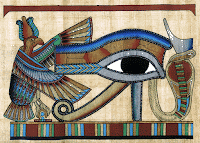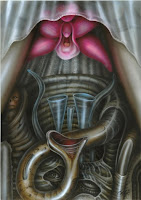AKHU – The Ka and Ba in union, the Holy Guardian Angel and Evil Genius joined. This is the Great Work defined, the union of opposites. In Thelemic view this would be The Beast 666 and Babalon conjoined.
ALGOL – From the Arabic 'Al Ghul', meaning 'Demon Star'. Algol is symbolized as the Chaos Star with an averse pentagram in it, representing the individual star or consciousness through Black Magick awakening. Algol itself is the image of Set in the aspect of the Prince of Darkness, being the manifestation of the Black Sun or opposite force of creation. Through Algol one may project any magical force necessary based on ones’ experience. Algol is the mirror of The Order of Phosphorus.
ALPHABET OF DESIRE – The aspect of congress with the subconscious and the spirits which are exterior of the self and within the self. This is the grammar which is unspeakable and is used in communion with the conscious self (Ego,I) and the subconscious self (Kia).
ANCESTRAL SHADES – Spirits, atavisms or familiars of the dead which return to us from our initiation into Magick and Witchcraft. Ancestral Shades may not always be past family, rather those who have been on the path before us who have gained immortality who for whatever reason decide to assist us. In the Black Order of the Dragon, such spirits are closely connected with the concepts of Varcolaci and the Undead Gods.
ANUBIS – Lord of Jackals and the Opener of the Way. Anubis is the funerary God that is represented as having the head of a jackal or dog. According to Charles Pace, the Bastard Son of SET-AN & ASET (Isis).
ATAVISTIC RESURGENCE – The return to consciousness the powers of the 'dead' or subconscious energies or powers from the pre-human aspects. Atavisms are evoked through intense Nostalgia and focus, often appearing in bestial forms.
ATHAME – The Blade of Holy Magick or Greater Black Magick workings, used in ceremonial or solitary practice. Pathally a black handled knife.
AZAZEL – Called the Guardian of the Goat, Azazel is one of the 200 original fallen angels, according to lore. It is considered that Azazel is the same as Shemyaza, the leader of the Watchers. The Zohar makes reference (in Vayeze 153a) about the Rider upon the serpent is "the evil Azazel". In Islamic lore, Azazel is the same as Eblis and considered by other lore as the first star (in reference to any angels) which would reveal him as Lucifer.
AZOTH – The Beginning and End in its spiritual aspect, Azoth is a form of Life and Death. From between comes the possibility of manifestation.
BA - the Soul in Egyptian mythology. When the immortal physically dies, the Ba, which is the Astral Body, lives on within the tomb and beyond. Ba may be seen as the Evil Genius of earth bound force often presented in Egyptian lore as a human headed bird. The Ba is the psyche and force which exists beyond the veil.
BALEFIRE – Ritual fire used in Coven gatherings.
BLACK FLAME – The illuminated essence of being, the concept that we perceive ourselves and our separate aspect from the natural order. The Gift of Set or Azazel.
CHALICE – The magickal cup used for Philters and ceremonies. While some covens and individuals use the silver cup, one may use a KAPALA as well, which is a human skull cap often imported from Tibet.
COVEN – A small group of magickal practitioners. Often 13 in number. Covens may be of a smaller size as well.
DAEMON – From the Greek Daimon, meaning ‘spirit’. The Daemon is the root of 'Demon' therefore represents the spirit of the sorcerer and the exterior spirits on the astral plane.
DJED – Egyptian, represents stability and strength, associated with the backbone in the funerary cult. In the union of the circle, Djed is the Holy aspect in union with the shadow of the magician, the very aspect of initiation towards the Great Work.
EVOCATION – The act of calling the spirit into and area, OUT from the self. Evocation generally involves servitors, familiars, and Daemons. A potent and dangerous aspect of ritual magick and sorcery is to evoke the force into the triangle, and then enter the triangle and Invoke the force, calling it in. This results in an aspect of possession and leads to higher developments of the consciousness and psyche.
FAMILIAR – The servitor or animal spirit which is associated with the Sorcerer. The familiar may be evoked and bound, or may be created by the individual to assist in the workings of sorcery. Called also the Famulus (Latin)
FETISH – An object from which the focus of a spirit or Coven item is charged. This is the home of the famulus and is an extension of the sorcerer.
HOLY GUARDIAN ANGEL – The True Will, the divine aspect of the self as the psyche, the immortal aspect of the mind which separates us from pure instinctual beings.
IBLIS - The fallen angel known as the Devil. The attribution of Iblis is that of the imagination, thus Lucifer is our imagination. While not widely accepted in the West, William Blake was one of the few to and attributes Satan to the mind. Iblis is derived from the Greek Diabolus. Iblis before the fall is known as Azazyl, whom is identical to the leader of the watchers.
INVOCATION – The act of calling the spirits IN, assuming consciousness from outer inspired sources. Invocation in the supplication of a force, to bring it in and absorb it. Some consider this Predatory Spiritualism which is related to Astral Vampirism.
KA – The vital force of life which is related to Ba. Ka may be seen as the Holy Guardian Angel, the spirit of Light and perfection in itself.
KAPALA – Human Skull Cap consecrated as a drinking cup or chalice. Pathally used in Tibetan Chod rites.
LYCANTHROPY – Assumption of astral and conscious transformation in to an animal form. Used in Dreaming Projection and atavistic rituals.
MANES – The shadow of the dead, spirit forms which may be controlled and absorbed by the sorcerer's own astral body. One may feed the servitors themselves from this, that they may take their shadow and from your Will form their shapes in darkness in whatever fashion you so desire.
NECROMANCY – Evocation and communion with the Dead.
SABBAT – The Meeting of Witches in the Dream Plane, the secret arcana of leaving the body. There are two aspects of the Sabbat, the Empyrean/Celestial (of Air – the Luciferian Sabbat) and the Infernal Sabbat (Chthonic, Demonic and Earth based). These two elements of the Dream Conclave are connected with the symbolism of which the Fraturnitias Saturni focused upon as the Higher and Lower Octave of Saturn.
SHADES – Shadows of the Dead, spirits which commune with the living. The Witches Sabbat path works with shades from Ancestral Manes and evoked spirits.
THANATOS – Death and the spirit therein. Thanatos is considered the death posture guide through which we meet the deep desire, Thanatos is the gateway therefore.
THEURGY – Holy or High Magick, practiced originally or defined by the Egyptian Platonists which commune with beneficial spirits is sought. This is a part of The Great Work of communion with the Holy Guardian Angel, and Greater Servitor or Familiar.
VAMPIRISM – A secret art of Predatory Spiritualism, which involves astral projection and aspects of Lycanthropy, communion with the dead and necromantic workings.
Source: Luciferian Sorcery, Michael W. York, 2003, Succubus Publishing, Houston.
Check: Sumerian connection (MIC)
Read more...




















